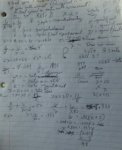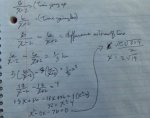I am going to go at this a completely different way.
You must define things to keep your mind from spinning. And, in the real world, you must frequently look for additional information beyond what is explicitly told to you and deal with multiple unknowns. So here is my method, which works every time without benefit of insight or familiarity with a specific type of problem.
Your first question was that there seemed to be too little information. GREAT QUESTION.
Identify the potentially relevant numbers that are unknown and name them.
\(\displaystyle x = \text {speed of boat in still water (no current).}\)
\(\displaystyle s_d = \text {speed downstream (with current).}\)
\(\displaystyle s_u = \text {speed upstream (against current).}\)
\(\displaystyle t_d = \text {time downstream (with current).}\)
\(\displaystyle t_u = \text {time upstream (against current).}\)
Five unknowns. So you need five numeric relationships that can be made into equations to find these numbers. But the problem
explicitly gives you only three numbers and one numeric relationship. Notice that you have not really done any math yet. You have been thinking about the problem. Well let's write down the one relationship we do know explicitly.
\(\displaystyle \text {I: } t_u = t_d + \dfrac{1}{3}.\)
We need four more relationships that are not explicitly given in the problem. Do I know a relationship between speed, time, and distance? Yes, I do
\(\displaystyle \text {II: } 6 = s_u * t_u.\)
\(\displaystyle \text {III: } 6 = s_d * t_d.\)
Do I know anything about speeds and currents? Yes, I do.
\(\displaystyle \text {IV: } s_u = x - 2.\)
\(\displaystyle \text {V: } s_d = x + 2.\)
This is just putting what you know into mathematical language. It is thinking. You think before you do math mechanics. But now we have a system of five equations in five unknowns. There is a purely mechanical way to solve it: substitution.
\(\displaystyle 6 = s_u * t_u \implies t_u = \dfrac{6}{s_u}.\)
\(\displaystyle 6 = s_d * t_d \implies t_d = \dfrac{6}{s_d}.\)
\(\displaystyle t_u = t_d + \dfrac{1}{3} \implies t_u - t_d = \dfrac{1}{3}.\)
\(\displaystyle \therefore \dfrac{6}{s_u} - \dfrac{6}{s_d} = \dfrac{1}{3}.\)
\(\displaystyle \therefore \dfrac{6}{x - 2} - \dfrac{6}{x + 2} = \dfrac{1}{3}.\)
What Subhotosh did in his head. But I am not as smart as Subhotosh so I must do it slowly.
Now it is a piece of cake. Multiply both sides of the equation by 3(x - 2)(x + 2) to clear fractions.
\(\displaystyle 18(x + 2) - 18(x - 2) = (x + 2)(x - 2) \implies 36 + 36 = x^2 - 4 \implies\)
\(\displaystyle x^2 = 76 = 4 * 19 \implies x = 2\sqrt{19}.\)
If you "see" what Subhotosh saw, then by all means do it that way because it is quick. If you struggle to "see" something, then get systematic: identify and name the relevant unknown numbers, find n relationships involving n unknowns, turn those into equations, and solve by substitution.





